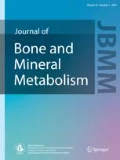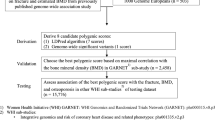Abstract
Pleiotropy has important implications for understanding the genetic basis and risk assessment of osteoporosis. Our aim was to identify pleiotropic genetic variants associated with the development of osteoporosis and predict osteoporosis risk by leveraging pleiotropic variants. We evaluated the effects of 21 conventional risk factors and 185 single-nucleotide polymorphisms (SNPs) in 63 inflammation- and metabolism-related genes on osteoporosis risk in a community-based Korean cohort study of 1025 participants, the Hallym Aging Study. Ten nongenetic factors, including sex (female) and hematocrit level, and 12 SNPs across ten genes showed evidence of association with incident osteoporosis in 270 initially osteoporosis-free subjects who completed a 6-year follow up. Three gene variants, rs1801282 (PPARG-Pro12Ala, hazard ratio (HR) = 3.26, P = 0.008), rs1408282 (near EPHA7, HR = 1.87, P = 0.002), and rs2076212 (PNPLA3-Gly115Cys, HR = 2.24, P = 0.024), were associated with significant differences in survival among the three genotype groups (Pdiff = 0.042, 0.003, and 0.048, respectively). Individuals in the highest polygenic risk score tertile were 27.9 fold more likely to develop osteoporosis than those in the lowest tertile (P = 0.004). The PPARG gene in particular was a hub pleiotropic gene in the epistasis network. Our findings highlight pleiotropic modulations of metabolism- and inflammation-related genes in the development of osteoporosis and demonstrate the contribution of pleiotropic genetic variants in prediction of osteoporosis risk.



Similar content being viewed by others
References
NIH Consensus Development Panel on Osteoporosis Prevention, Diagnosis, and Therapy (2001) Osteoporosis prevention, diagnosis, and therapy. JAMA 285:785–795
Sambrook P, Cooper C (2006) Osteoporosis. Lancet 367:2010–2018
Park EJ, Joo IW, Jang MJ, Kim YT, Oh K, Oh HJ (2014) Prevalence of osteoporosis in the Korean population based on Korea National Health and Nutrition Examination Survey (KNHANES), 2008–2011. Yonsei Med J 55:1049–1057
Duncan EL, Brown MA (2010) Clinical review 2: genetic determinants of bone density and fracture risk: state of the art specific regulation of bone mass. J Clin Endocrinol Metab 95:2576–2587
Thulkar J, Singh S, Sharma S, Thulkar T (2016) Preventable risk factors for osteoporosis in postmenopausal women: systematic review and meta-analysis. J Midlife Health 7:108–113
Clark GR, Duncan EL (2015) The genetics of osteoporosis. Br Med Bull 113:73–81
Karasik D, Rivadeneira F, Johnson M (2016) The genetics of bone mass and susceptibility to bone diseases. Nat Rev Rheumatol 12:323–334
Eichler EE, Flint J, Gibson G, Kong A, Leal SM, Moore JH, Nadeau JH (2010) Missing heritability and strategies for finding the underlying causes of complex disease. Nat Rev Genet 11:446–450
Styrkarsdottir U, Thorleifsson G, Sulem P, Gudbjartsson DF, Sigurdsson A et al (2013) Nonsense mutation in the LGR4 gene is associated with several human diseases and other traits. Nature (Lond) 497:517–520
Styrkarsdottir U, Thorleifsson G, Eiriksdottir B, Gudjonsson SA, Ingvarsson T, Center JR, Nguyen TV, Eisman JA, Christiansen C, Thorsteinsdottir U, Sigurdsson G, Stefansson K (2016) Two rare mutations in the COL1A2 gene associate with low bone mineral density and fractures in Iceland. J Bone Miner Res 31:173–179
Zheng HF, Forgetta V, Hsu YH, Estrada K, Rosello-Diez A et al (2015) Whole-genome sequencing identifies EN1 as a determinant of bone density and fracture. Nature (Lond) 526:112–117
Sennerby U, Melhus H, Gedeborg R, Byberg L, Garmo H, Ahlbom A, Pedersen NL, Michaëlsson K (2009) Cardiovascular diseases and risk of hip fracture. JAMA 302:1666–1673
Ackert-Bicknell CL (2012) HDL cholesterol and bone mineral density: is there a genetic link? Bone (NY) 50:525–533
Billings LK, Hsu YH, Ackerman RJ, Dupuis J, Voight BF et al (2012) Impact of common variation in bone-related genes on type 2 diabetes and related traits. Diabetes 61:2176–2186
Zhao F, Gao LH, Li SS, Wei ZY, Fu WZ, He JW, Liu YJ, Hu YQ, Dong J, Zhang ZL (2016) Association between SNPs and haplotypes in the METTL21C gene and peak bone mineral density and body composition in Chinese male nuclear families. J Bone Miner Metab 35:437–447
Karasik D, Kiel DP (2010) Evidence for pleiotropic factors in genetics of the musculoskeletal system. Bone (NY) 46:1226–1237
Li C, Yang C, Gelernter J, Zhao H (2014) Improving genetic risk prediction by leveraging pleiotropy. Hum Genet 133:639–650
Manolio TA, Bailey-Wilson JE, Collins FS (2006) Genes, environment and the value of prospective cohort studies. Nat Rev Genet 7:812–820
Jang SN, Choi YH, Choi MG, Kang SH, Jeong JY, Choi YJ, Kim DH (2006) Prevalence and associated factors of osteoporosis among postmenopausal women in Chuncheon: Hallym Aging Study (HAS). J Prev Med Public Health 39:389–396
Cho YG, Song HJ, Lee SK, Jang SN, Jeong JY, Choi YH, Hong KS, Choi MG, Kang SH, Kang JH, Kim DH, Caterson I (2009) The relationship between body fat mass and erectile dysfunction in Korean men: Hallym Aging Study. Int J Impot Res 21:179–186
Hong EP, Kim DH, Suh JG, Park JW (2013) Analyses of longitudinal effects of gene-environment interactions on plasma C-reactive protein levels: the Hallym Aging Study. Genes Genom 35:131–139
Solovieff N, Cotsapas C, Lee PH, Purcell SM, Smoller JW (2013) Pleiotropy in complex traits: challenges and strategies. Nat Rev Genet 14:483–495
Sivakumaran S, Agakov F, Theodoratou E, Prendergast JG, Zgaga L, Manolio T, Rudan I, McKeigue P, Wilson JF, Campbell H (2011) Abundant pleiotropy in human complex diseases and traits. Am J Hum Genet 89:607–618
Jorgensen TJ, Ruczinski I, Kessing B, Smith MW, Shugart YY, Alberg AJ (2009) Hypothesis-driven candidate gene association studies: practical design and analytical considerations. Am J Epidemiol 170:986–993
Szczerbal I, Foster HA, Bridger JM (2009) The spatial repositioning of adipogenesis genes is correlated with their expression status in a porcine mesenchymal stem cell adipogenesis model system. Chromosoma (Berl) 118:647–663
Debril MB, Renaud JP, Fajas L, Auwerx J (2001) The pleiotropic functions of peroxisome proliferator-activated receptor gamma. J Mol Med (Berl) 79:30–47
Ge C, Cawthorn WP, Li Y, Zhao G, Macdougald OA, Franceschi RT (2016) Reciprocal control of osteogenic and adipogenic differentiation by ERK/MAP kinase phosphorylation of Runx2 and PPARγ transcription factors. J Cell Physiol 231:587–596
Yue H, He JW, Zhang H, Hu WW, Hu YQ, Li M, Liu YJ, Wu SH, Zhang ZL (2010) No association between polymorphisms of peroxisome [corrected] proliferator-activated receptor-gamma gene and peak bone mineral density variation in Chinese nuclear families. Osteoporos Int 21:873–882
Rhee EJ, Oh KW, Yun EJ, Jung CH, Park CY, Lee WY, Oh ES, Baek KH, Kang MI, Park SW, Kim SW (2007) The association of Pro12Ala polymorphism of peroxisome proliferator-activated receptor-gamma gene with serum osteoprotegerin levels in healthy Korean women. Exp Mol Med 39:696–704
Namvaran F, Rahimi-Moghaddam P, Azarpira N, Dabbaghmanesh MH, Bakhshayeshkaram M, Namvaran MM (2013) Changes in bone biological markers after treatment of Iranian diabetic patients with pioglitazone: no relation to polymorphism of PPAR-γ (Pro12Ala). J Res Med Sci 18:277–282
Wei W, Zeve D, Suh JM, Wang X, Du Y, Zerwekh JE, Dechow PC, Graff JM, Wan Y (2011) Biphasic and dosage-dependent regulation of osteoclastogenesis by β-catenin. Mol Cell Biol 31:4706–4719
Yilmaz MB, Pazarbasi A, Guzel AI, Kocaturk-Sel S, Kasap H, Kasap M, Urunsak IF, Basaran S, Alptekin D, Demirhan O (2011) Association of serum sex steroid levels and bone mineral density with CYP17 and CYP19 gene polymorphisms in postmenopausal women in Turkey. Genet Mol Res 10:1999–2008
Garg G, Kumar J, McGuigan FE, Ridderstråle M, Gerdhem P, Luthman H, Åkesson K (2014) Variation in the MC4R gene is associated with bone phenotypes in elderly Swedish women. PLoS ONE 9:e88565
Ferrari SL, Ahn-Luong L, Garnero P, Humphries SE, Greenspan SL (2003) Two promoter polymorphisms regulating interleukin-6 gene expression are associated with circulating levels of C-reactive protein and markers of bone resorption in postmenopausal women. J Clin Endocrinol Metab 88:255–259
Hong EP, Kim DH, Suh JG, Park JW (2014) Genetic risk assessment for cardiovascular disease with seven genes associated with plasma C-reactive protein concentrations in Asian populations. Hypertens Res 37:692–698
Ligthart S, Vaez A, Hsu YH, Inflammation Working Group of the CHARGE Consortium, PMI-WG-XCP, LifeLines Cohort Study, Stolk R, Uitterlinden AG, Hofman A, Alizadeh BZ, Franco OH, Dehghan A (2016) Bivariate genome-wide association study identifies novel pleiotropic loci for lipids and inflammation. BMC Genomics 17:443
Xi HQ, Wu XS, Wei B, Chen L (2012) Eph receptors and ephrins as targets for cancer therapy. J Cell Mol Med 16:2894–2909
Matsuo K, Otaki N (2012) Bone cell interactions through Eph/ephrin: bone modeling, remodeling and associated diseases. Cell Adh Migr 6:148–156
Posadas-Sánchez R, López-Uribe ÁR, Posadas-Romero C, Pérez-Hernández N, Rodríguez-Pérez JM, Ocampo-Arcos WA, Fragoso JM, Cardoso-Saldaña G, Vargas-Alarcón G (2016) Association of the I148 M/PNPLA3 (rs738409) polymorphism with premature coronary artery disease, fatty liver, and insulin resistance in type 2 diabetic patients and healthy controls. The GEA study. Immunobiology. https://doi.org/10.1016/j.imbio.2016.08.008
Liu CT, Young KL, Brody JA, Olden M, Wojczynski MK et al (2014) Sequence variation in TMEM18 in association with body mass index: cohorts for heart and aging research in genomic epidemiology (charge) consortium targeted sequencing study. Circ Cardiovasc Genet 7:344–349
Sleiman P, Wang D, Glessner J, Hadley D, Gur RE, Cohen N, Li Q, Hakonarson H, Janssen-CHOP Neuropsychiatric Genomics Working Group (2013) GWAS meta analysis identifies TSNARE1 as a novel schizophrenia/bipolar susceptibility locus. Sci Rep 3:3075
Grimes DA, Schulz KF (2002) Cohort studies: marching towards outcomes. Lancet 359:341–345
Daniel M, Martin AD, Drinkwater DT (1992) Cigarette smoking, steroid hormones, and bone mineral density in young women. Calcif Tissue Int 50:300–305
Felson DT, Zhang Y, Hannan MT, Kannel WB, Kiel DP (1995) Alcohol intake and bone mineral density in elderly men and women. The Framingham Study. Am J Epidemiol 142:485–492
Estrada K, Styrkarsdottir U, Evangelou E, Hsu YH, Duncan EL et al (2012) Genome-wide meta-analysis identifies 56 bone mineral density loci and reveals 14 loci associated with risk of fracture. Nat Genet 44:491–501
Warrington Nicole M, Kemp John P, Tilling Kate, Tobias Jonathan H, Evans David M (2015) Genetic variants in adult bone mineral density and fracture risk genes are associated with the rate of bone mineral density acquisition in adolescence. Hum Mol Genet 24:4158–4166
Acknowledgments
This research was supported by the Basic Science Research Program of the National. Research Foundation of Korea (NRF) funded by the Ministry of Education, Science and Technology (2014R1A1A3053168), the Bio & Medical Technology Development Program of the National Research Foundation of Korea (NRF) funded by the Ministry of Science, ICT & Future Planning (NRF-2012M3A9D1054450), and Hallym University Research Fund 2017 (HRF-201704-015). We are greatly thankful to all participants and staff in the Hallym Aging Study for their contribution to the project.
Author information
Authors and Affiliations
Corresponding author
Ethics declarations
Conflict of interest
All authors have no conflicts of interest.
Electronic supplementary material
Below is the link to the electronic supplementary material.
About this article
Cite this article
Hong, E.P., Rhee, K.H., Kim, D.H. et al. Identification of pleiotropic genetic variants affecting osteoporosis risk in a Korean elderly cohort. J Bone Miner Metab 37, 43–52 (2019). https://doi.org/10.1007/s00774-017-0892-x
Received:
Accepted:
Published:
Issue Date:
DOI: https://doi.org/10.1007/s00774-017-0892-x




